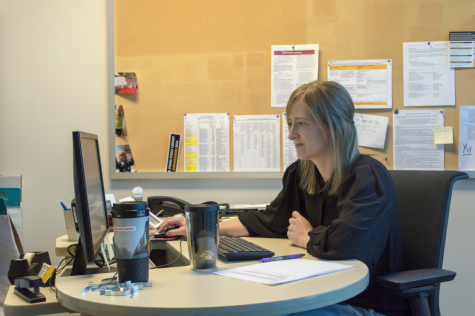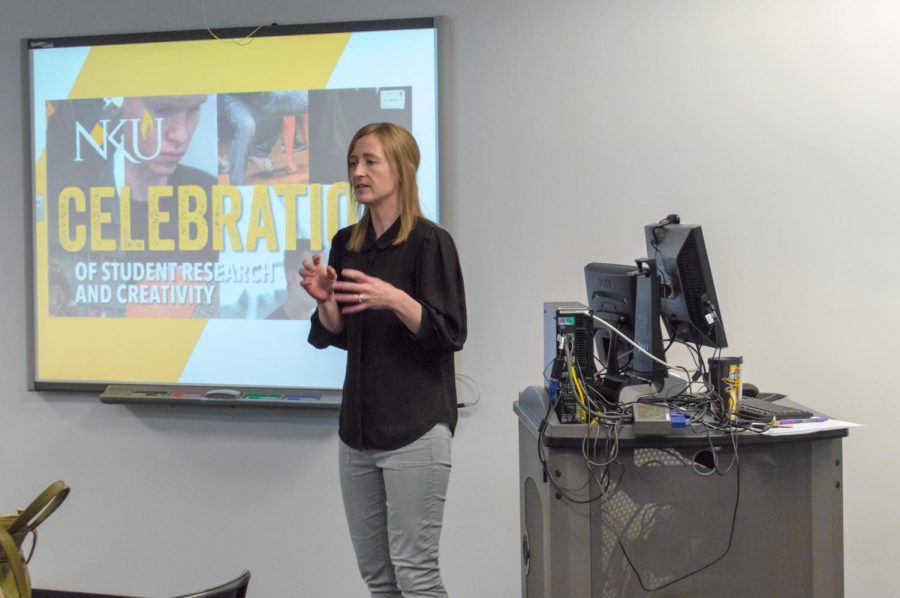Steely librarian on information literacy mission
February 13, 2019
Andrea Brooks, Steely Library’s information coordinator, teaches how to analyze sources.
Andrea Brooks writes her name, email and agenda for the day on the whiteboard of a deserted classroom. She powers up the ENO board. It’s just before 10 a.m., and not a single student is present, although the classroom door is open for any early comers.
Brooks is the Information Literacy Coordinator and teaches courses to undergraduate and graduate classes who usually meet in the library. This means the professor of the course as well as the students meet with Brooks.
Brooks continues to work at her computer, twirling her blonde ponytail as she thinks. Professor Kathleen Fuegen and her 16 PSY 210 students file in for Brooks’ lecture on recognizing different types of sources, how to trace information and search strategies. This is her only undergraduate class for the day.
The students are spread throughout the room, sitting at large round tables with laptops around each table. The students follow Brooks’ directions to access a Google document, which was meticulously written on the board to be copied exactly into the address bar. Once there, the students participate in an activity where, upon viewing different sources, they must be able to identify each by its name. A soft chatter arises as the students begin the activity.
Brooks also directs the students to Steely Library’s website to offer tips on how to search more effectively for sources. She indicates the sidebar on the webpage that allows the search to be narrowed down by author or limited within a certain time. She also shows students how to search with keywords, recommending only using two to four words and putting quotes around specific phrases they may want to see within the source, like “college athletes.”
Brooks is an information librarian and works on the information literacy initiative, which is a five-year program that attempts to incorporate information literacy into each field of study. She said this plan would take the place of the “one-shot” courses that teach students how to research for a particular assignment.
“There’s also the whole component of misinformation today and being a responsible information consumer because we’re also sharing information so much,” Brooks said. “So [we’re] trying to expand beyond ‘be successful at your assignment,’ which is good, we want you to succeed at your assignment, but it’s bigger than that I think.”
Library Informatics Advisor Lynn Warner said the older definition is being able to identify information needed as well as other related, relevant information to be evaluated and used properly.
Warner explained that now the understanding is that students are not only using information, they are creating it as well, saying that the older definition is more “passive” and now the understanding for information literacy is more “active.”
After about an hour, the class is over and Brooks heads to her office. She works on creating modules which, she explained, can be imported into the “Commons,” a resource on Canvas for instructors to share material.
She returns to office to email her fellow, fill out a Girl Scouts cookie order form, clear off Post-It notes of completed tasks, check her phone to see a picture of her four-year-old nephew skiing, eat lunch, takes a phone call about a presentation and goes through all her emails saying, “It’s been a good month, but a crazy one.”

Andrea Brooks, Steely Library’s information coordinator, teaches how to analyze sources.
She leaves for her next class being held in the Health Innovation Center. She gets a little lost along the way, but finds the right room just before her next class starting at 12:30 p.m.
The perimeter of the room is lined with computers, the far wall painted a magenta color while the remaining walls are see-through, and 27 desks pointed toward the front of the room where Brooks will lecture to 11 social work students.
This presentation is to teach graduate students how to best access Steely Library’s resources and participate in NKU’s research event, Celebration. She explained the differences between Articles+, a database for their particular field and Google Scholar, with tips on how to narrow or broaden one’s search.
She reminds students that research is a “conversation” and they have the opportunity to contribute. She breaks down the requirements for “Celebration” and shows the help that NKU has to offer.
She also encourages students to submit their applications for a cash prize and recognition that Steely Library offers. The due date for these applications is set after the “Celebration” event to give students time to write about how they used Steely Library’s resources in their research and submit their application.
After Brooks gives tips on how to participate Celebration research, the professor tells her students to each share something they found helpful from Brooks’ presentation. No other class contributed in this way, but it did provide Brooks with immediate feedback.
Brooks then dashes from the Health Innovation Center to Steely Library. She has two more graduate classes to teach with a short break to continue working on a module before her day is done.
Brooks is not the only librarian to break the stereotype.
Professor Mary Chesnut has two black and white pictures of rigid, “stern” women that remind her of “stereotypical” librarians. These pictures remind her to “never become like them.”
Her office is decorated with old greeting cards, while Funko figures line the far wall. Her door has Allied Zone stickers, a first-generation student flyer and her name “Mary” in Scrabble tiles.
“I get to do lots of fun things here; every day is a little bit different,” Chesnut said. “I’m not just stuck at the computer; I’m not just stuck doing one thing or another; I’ve got a variety of things to do and it’s never boring.”

